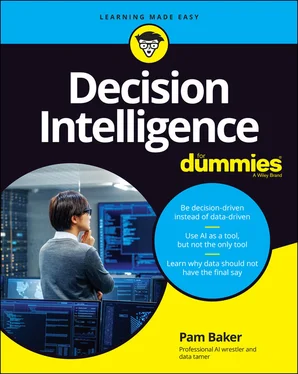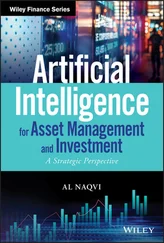What differentiates one decision intelligence project from another is the talent and acumen of the decision makers at the helm. They make the recipe that cooks the business value into the process. And they decide when and whether to invite data and machines to the planning table.
Decision intelligence is highly agile and versatile. Decision makers can use it to make decisions either on the back of a napkin or with the help of the most sophisticated AI on the planet.
The Tale of Two Decision Trails
The business world has long been madly in love with the notion of being a data-driven enterprise, but it's also beginning to feel the pain of being in a bad relationship. Few actually want to break off their relationship with data entirely, mainly because most are loathe to ditch their significant investments in data, analytics, and related technologies. Add to this the fact that, for many, it would feel like a colossal failure and a huge embarrassment to fall short of becoming the data driven enterprise that all investors and stockholders expect these days.
Looking for a way forward, many started to ask themselves this question: “What can we do with all the data investments we've already made and already own in order to make better decisions?” In other words, folks realized that a rethink was needed rather than a redo . And many of those same folks decided that re-strategizing and restructuring how these same investments are used and aligning them with specific business impacts was the answer to the questions that had been plaguing them.
 A decision intelligence approach doesn’t mean that there’s no place for more traditional data mining tactics. Most organizations are using a combination of both, and it’s already proving to be a winning play for many of them.
A decision intelligence approach doesn’t mean that there’s no place for more traditional data mining tactics. Most organizations are using a combination of both, and it’s already proving to be a winning play for many of them.
AI and data analytics no doubt deliver real business value in some use cases. They’re helpful when it comes to recognizing patterns in massive amounts of data and spitting out equations, scores, predictions, and estimates. The point is that such facts point to possible decisions but suggest none. (That's why I refer to the outputs from such tools as pointers in this section.)
These tools are also capable of automating certain decisions based on business rules that are determined and set by you or your organization. At its core, AI is automated decisions at scale. Traditional analytics must be integrated with automation software to cause an action to occur.
But before the various software — analytics, AI, and various forms of automation — begin their work in producing insights and automating your decisions, someone has to either program the analytics and automation software, and/ or train the AI. This group of data professionals often provide the interpretations of the outputs as well (usually as visualizations and/or automated AI-generated narratives).
In other words, people in specific job roles who do these tasks typically determine which insights — pointers, in other words — are accessible to other people in the organization who either use the software in a much more limited way or only view the results on dashboards to consume the information. Given the high degree of data illiteracy throughout organizations and across countries and industries, this process is both logical and necessary.
The downside here is that it is also limiting what information end-users can access when it comes to their own decision-making processes and what prompts the direction their thinking takes. This is why data democratization and AI democratization — decentralization so that more people in the organization can use the tools — is so critical to businesses. By making these tools far more user-friendly, professionals in other disciplines and employees at all levels of the business can make better use of these resources.
However, both data and AI democratization still require data professionals to develop more intuitive and highly automated software to remove barriers before non-data professionals can use the tools in ways that bring their own talents and skill sets to bear. Think of this as very similar to the path other software has taken. For example, Microsoft Office enables people to create documents, notes, spreadsheets, and PowerPoint presentations without knowing how to write code, what keyboard commands to give, or anything at all about how the software works. This is the path analytics and AI software are headed down now.
So, who are these data professionals who are making and/or using analytics and AI to provide you with the pointers you’re currently getting from various analytics software?
Typical job roles in data mining and analytics are data scientist, business analyst, data mining specialist, and data mining engineer (and variations of the same) to reflect a specific industry such as healthcare data analyst and risk-mining data scientist.
In AI, job roles include AI scientist, AI researcher, business intelligence developer, robotic scientist, software architect, data scientist, and data engineer, among others.
All these jobs will continue to be important positions in many organizations, and the demand for people with these skills will remain high for the foreseeable future.
However, much of their work is also being automated as part of the data and AI democratization movements.
As to specific examples of the work that these professionals collectively and individually produce for use in several business areas, below are some of the more common use cases for traditional data analytics and/or AI automated decision making:
Anomaly detection, also known as outlier analysis, is a step in data mining (which can be aided by AI/ML or not) that finds deviations in the data from the norm, such as events (purchases on a charge or debit card in another country from where the cardholder is known to live or be, for example), and data point changes (attempts to change a social media account’s password via a device or browser that the true account holder is not known to use before, for example).
Pattern recognition is the automated recognition of patterns discovered in the regularities in data. One example would be finding earlier signs of cancer in patient data than doctors and diagnosticians previously knew existed.
Predictive modeling, also known as predictive analytics, analyzes historical patterns in the data using a mathematical process to predict future events or outcomes. One example would involve predicting when a machine part will need repair or replacement based upon its past usage compared to how long identical parts lasted under the same conditions.
Recommendation engines analyze data to make recommendations or suggestions based on users’ past behaviors. Examples include analyzing your purchasing patterns in order to offer you a coupon for a grocery item you should be ready to buy again soon, or to recommend a movie based on movies you watched and rated earlier.
Personalization systems use data analysis to customize a service, product, or automated communication. Examples include marketing emails sent to large numbers of customers, each personalized with the customer’s name and a custom discount offer for a favorite product or service.
Classification and categorization systems automate the organization of vast amounts of data. Examples include sorting data files and data sets according to importance, topic, secrecy level, or other identifier; legal requirements governing the handling of specific data points (think of laws like General Data Protection Regulation (EU GDPR) which limit where personal data can be stored); and the nature of the data (such as structured machine data or unstructured Twitter posts). Data must be correctly classified and categorized for analytics or AI to work correctly. Automation is the ticket here because there’s so much data that it’s impossible to do it manually.
Читать дальше

 A decision intelligence approach doesn’t mean that there’s no place for more traditional data mining tactics. Most organizations are using a combination of both, and it’s already proving to be a winning play for many of them.
A decision intelligence approach doesn’t mean that there’s no place for more traditional data mining tactics. Most organizations are using a combination of both, and it’s already proving to be a winning play for many of them.










